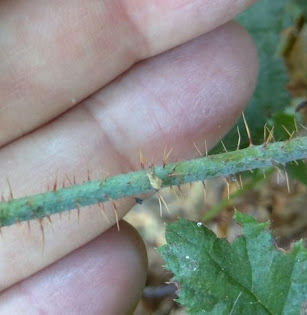Identification of Rubus ursinus vs Rubus armeniacus
A note before I begin: Rubus taxonomy is a mess right now. The native Californian species are pretty well defined, but the European / Asian originating ones (often called "Himalayan Blackberry") don't really fit neatly into our current taxonomic concepts. You will see many different names applied to non-native Rubus on the West Coast, and it's unclear if they should all be considered the same species or several different species, and what features should distinguish them from each other if they are different.
Various sources you will run across may refer to these plants as Himalayan Blackberry (Rubus bifrons), Armenian Blackberry (Rubus armeniacus), European Bramble Complex, Rubus discolor, Rubus fruticosus, Rubus vestitus, and probably a dozen other names as well. The Japson Manual calls these plants R armeniacus, so for the purposes of this guide, that is how I will refer to them.
So the most obvious difference between R armeniacus and R ursinus is the shape of the spines on the stem. For best results, look at the spines on the older parts of the plant; they're more likely to be fully developed.
 |
| Rubus ursinus / photo by jimkingdon |
 |
| Rubus armeniacus / photo by kdeblonk |
Notice also the shape of the stems - Rubus armeniacus has ridges running along the stem, and in cross-section will look somewhat hexagonal. R ursinus has no ridges, and will appear round in cross-section.
Younger and smaller specimens of R armeniacus will not always show the ridges as well as large, older canes, but will usually have at least some flattening of the sides of the stems.
Here's a few compilations of the thorns to give an idea of the variations:
 |
| Rubus ursinus thorns |
 |
| Rubus armeniacus thorns |
And some of the younger leaves on this R ursinus are fused into a single leaf:
Finally, let's talk about flowers and fruit clusters.
R armeniacus has large clusters of around 10 to 20 flowers, located at the ends of the canes or branches. The flowers are 5-petaled, with wide rounded petals, colored white to pink.
R ursinus has clusters with usually 1 to 5 flowers, growing on small branches coming off the sides of the main canes. The flowers are usually white, with narrow petals, and generally have 5 petals though it is not uncommon to have anywhere from 3 to 20+ petals on a given flower.







Comments
Post a Comment